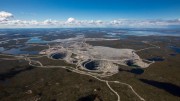Asking miners to work on their Human Resources strategy when the industry horizon appears to hold little that is positive may appear futile. But changes already underway in the employment market are going to impact on those plans, and when these times have passed, miners may be glad they did.
Previous talent wars were dire, but the industry survived with proven solutions.
This time the circumstances are different and the old solutions may not be as successful. Hiring rapidly in an upswing, paying well and shedding staff on the downturn is already becoming an unacceptable model. The industry was accustomed to a (mostly) ample supply of homogenous talent, but engineering no longer attracts enough recruits. Mine schools are shuttered and reduced graduate intakes in prior downturns have created gaps in the supply of succession candidates for management positions. Families are changing too: working spouses and shared parenting duties mean less willingness to fly in and fly out to mines in increasingly remote spots.
By the time the industry begins to turn, the baby boomers — for so long the go-to group, the “safe hands” of the industry — will be well advanced in their exit of the workplace. There are nine years before the last of that cohort hits 65, but plan on that experience being less available as the window closes, even as a stopgap. Several years on the golf course means that they are going to be out of touch and may have expectations of previous salary levels, making them an expensive alternative in the current environment.
Mining recruiting specialist Chris Stafford wrote recently about the importance of building bridges with educational establishments.
Graduate recruits will prove to be incredibly valuable, willing to do anything, and grateful for the opportunity. Eventually they will make strong succession candidates who, with some planning, will get to learn all aspects of the business. There are going to be fewer available skills that will require a talent plan to identify in advance, and skills gaps that will need to be filled through training, recruitment or consultants.
A progressively younger workforce is going to have different workplace expectations. They could treat work as a commodity found via the Internet and fuelled by recruiters advising that longer than four years with one employer is a limiting experience. They will seek companies with strong employment brands (reputations) who can deliver what they need in terms of personal development, project experience and culture. That’s a different type of consumer than the industry has been used to.
To attract the best, employers will have to adapt. Recruitment will become less about “finding” and more about “attracting.”
Employees are going to be less loyal. They will easily be able to find, or be recruited away to, alternative work. Mix that with the values of the remaining baby boomer group, and the workplace may become ripe for friction.
New leadership skills are going to be required. Harnessing the older cohort to share their experience with newcomers will be an important component of this environment. Surveys show that older employees are keen to leave their legacy, and so managing a willing knowledge transfer will be an important leadership task that will contribute to productivity.
Mining can learn from other industries that have already had to adapt workplace cultures to engage generational mixes. There is enough statistical data to show that happy employees are more productive and cost less. They give more of their discretionary effort, are absent less and stay with an employer for longer. In the case of mining, we can also expect two further important areas of improvement from engaged employees: safety and innovation.
Happiness was always assumed to be a by-product of a well-managed workplace. Now it will need to be a target, and allowing employees to have their say will be an important component. What makes for a happier workplace will vary by organization, site and employee profile. Employee surveys common in other industries will help identify needs but once asked, be prepared to act. To ask and do nothing will be viewed more poorly than not asking at all. Make way for a more democratic workplace.
As a consequence expect to be more transparent about the rationale behind human resource policies.
Unlike baby boomers, their successors have been taught to ask why. That’s not to say they are going to be disappointed with the answer, but an employer will need to be able to respond when asked. This applies to all things that touch the workforce, e.g., pay, incentive allocation, leave and job evaluation.
Visible equity and fairness are going to be expected features of the new workplace. Not that they aren’t present today, but explanations were less important or needed by baby boomers. Motivated more by money, employers relied on higher compensation to recruit scarce and unproven talent. That is no longer going to be an option, and besides, it will likely undermine carefully crafted workplace equity.
Salaries in the Canadian mining sector increased disproportionately to the rest of the economy during the super cycle because of an inadequate talent supply in a global industry with pay disparity. This was not the case in other industries that had to find alternate ways to motivate productivity improvement. The engagement of the workforce became an important initiative.
As salaries in mining revert to more economic norms and the workplace changes, performance incentives will need to adapt.
Incentives need to directly reward performance and not comprise a discretionary “bonus” that encourages activity. Educating employees on how their work affects that of their colleagues creates a human connection and motivates collaborative endeavour. Reinforcing that with a share in the financial gains from effective collaboration could be a crucial development in improving mine performance in this new environment.
Long-term incentives have reflected the slide in share prices and as a retention device their utility — which was always questionable — has been undermined further. Extensive use of stock or equivalents to preserve cash has meant that many companies have reached insider limits and no desire for extensions from shareholders.
Targeting engagement represents another approach to reducing turnover. This doesn’t mean that those critical to a project cannot be rewarded relative to their contribution. They must be, but within a more visible framework that recognizes what everyone else in the team already knows and consequently, what will not disturb an equitable workplace.
Elliot Jacques developed the theory of felt-fair pay as part of his Requisite Management model years ago, and perhaps we are returning to a form of that. There will be recognition that the workforce’s future is tied to retention of key personnel.
Emphasis will shift to rewarding contribution and not relative position to a survey.
Mobile skills will not be excluded from these changes. More flexible working arrangements and family benefits will be required to accommodate young families who are asked to relocate or be apart for periods that are likely to be shorter than older cohorts were prepared to consider.
Creating a place where people want to work will promote innovation and value creation. Other industries confronted with years of low salary inflation and now changing values have come to realize that a happier or engaged workforce is an alternate way to increase productivity.
Incentive compensation, to be motivational in this environment, must be reinvented.
The expectations of patient investors will be for lower production costs. Other industries have reduced costs and improved productivity by working towards a desirable workplace. Mining might also benefit from this model.
The generational shift will be a slow transition that will create an increasing drag on performance if not addressed. Different age groups will have different expectations and getting the most from the mix will require deft leadership. Every mine will be affected by changing demographics and the impact of potentially conflicting values.
Reviewing an organization’s exposure, let alone making plans, may be a bridge too far while many mining companies contemplate survival. There are bigger issues to worry about.
CEOs will convince themselves that they can predict the turn and recruit the skills they need over their competitors, or that the old values are going to return when younger people feel the financial bite of more children. Some will say that their employment brands already reflect these values. If everyone thinks like that, not everyone will win. The best will not be hired — productivity advantages lost, innovation stagnated and generational conflicts undermine (no pun intended) collaboration. None of these symptoms appear on traditional financial statements, and will take time to identify and correct when everyone is busy with other things.
That being the case, where is the harm in a little upfront risk mitigation?
Start by assessing dependence and exposure to baby boomer employees to show the preparation that may be required and the time frame that you have. If this exercise reveals limited exposure or skills that are redundant and can be replaced by with less experience, the assessment may be complete.
If more exposure is indicated a deeper HR review should commence that comprises:
1. Skills assessment — How will our skills need to change in the next five years and how will these be acquired or replaced as current employees retire? What is the timing and extent of the generational mix and the likely leadership impact?
2. Skills acquisition plan — Plan how skills will be obtained so that the process can be triggered as timing dictates — don’t leave it until needed or until everyone else starts to do the same. If acquisitions are contemplated, ensure that key talent is assessed and able to be part of the transaction.
3. Graduates — Even if there is no immediate role, the cost will be minimal with a huge return on investment over time. A willing, grateful employee will be acquired who will eventually form part of the succession plan. Hire at least one.
4. Leadership skills — A talent plan will project the likely extent and duration of the generational mix in the workforce. Managing a blended workforce and transferring knowledge between generations in a more democratic workplace are leadership skills that may not be available today. Do you train or hire these?
5. Engagement of the workforce — To increase productivity and reduce employment costs make employees happier. This is not how miners usually think, but other industries have found it works! What is the risk in asking your employees what they want? This is not an evangelical experience, it is a commercial activity. Monitor metrics to assess the results of any changes that you make – some may not have the desired effect, but all should be targeted at a desired outcome.
6. Reliance on pay — To attract the best skills to this new environment, build a stronger employment brand rather than throw money at candidates. Financial incentives will continue to have an important part to play, but may perhaps need to refocus to emphasise collaborative behaviour.
Employees will represent the difference between exceptional and mediocre enterprise performance at a time when shareholder expectations will be high. Most companies acknowledge people as their most important asset, but times change, and so do people — in ways that may affect the workplace. Be prepared to adapt and profit.
— Paul Pittman is the senior partner and founder of The Human Well (www.thehumanwell.com), a collaborative HR consulting practice located in Oakville, Ont., with clients globally that helps mining companies develop and manage expatriate programs. He previously held executive HR positions with Alcan, RJR Nabisco/Japan Tobacco, Laidlaw and Massey-Ferguson, and was the Canadian HR practice leader for Arthur Andersen. He has lived in the U.K., Canada and Switzerland, and managed pension, benefit and compensation plans globally.





Be the first to comment on "What an HR manager can do in a downturn"